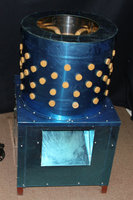Bellsouth Poultry Equipment Poultry Information Learning Resource Sheets Plucking Tips
Plucking tips

Poultry Plucking Tips
Often poultry plucking is regarded as a simple process, and if our birds are always the same age, weight, and breed then it is easy. But for the hobbyist, it’s often not so easy, because of all these variables.
These notes are intended to assist in the development of the skills needed, without I hope, making it sound too complicated. It really is straight forward but a few principles always makes it easier.
There are four stages to good poultry plucking:
1.) Select the bird at the right age
2.) Scald the bird correctly
3.) Pluck right way
4.) Treat the bird right after plucking.
1.) Selecting the bird at the right age is important. The birds develop several sets of feathers as they grow. The early stage of these feathers as they just emerge is called pin feather stage. Plucking birds with pin feathers is always much more difficult, so I recommend selecting the birds after pin feathers have unfurled. So check the birds and if they have pin feathers wait another week and usually they are unfurled and will pluck without lots of manual clean up afterwards. Very old birds and very young birds often have skin which is thinner and less resilient to the plucking process, which is more prone to tearing. These birds need more careful scalding and attention during plucking to avoid skin tears. Please note: with ducks it is sometimes impossible to pick a time when there is no pin feathers so wax dipping after plucking is used to remove the pin feathers
2.) Scalding is the process of dipping the birds in hot water to cause the release of feathers, the combination of time and temperature are important. The difference methods are called hard scald and soft scald. If the birds are for immediate consumption, then hard scalding at higher temperatures and for short times is acceptable. This is usually done at 60-65 degrees for just enough time for the leg feathers to come off when rubbed with the thumb. This combination can cause some blotchiness of the skin, not so pretty with roasting birds and also the high temperatures tend to reduce shelf life. Soft scalds is usually at 45-55 degrees and is less likely to damage the skin but takes longer to reach the point where the feather release under a little rub with the thumb. If you want to fridge them for a week then better to soft scald. Record the time and temperature for each combination of breed and age you use so that it is easy to repeat next time.
3.) Plucking. Good plucking is a combination of the right number of birds, the right time of plucking and the right removal of feathers. The bird in the plucker should tumble in such a way that it is tumbling end over end but sideways at the same time, a sort of rotating diagonal tumble. This means all sides of the bird pluck evenly. If you have too many birds in the plucker they cease to rotate correctly and slide around plucking one side and leaving the rest poorly plucked. Add extra birds with each plucking batch and when they cease to rotate you can make a note, to only pluck one or two less of that breed, age and weight combination. You may need to remove wing flight and tail feathers before plucking, usually it’s possible to pull them one handful for the tail and one handful each wing. Plucking time is an observation, and will vary according to the type of bird and feather cover. Over plucking, can damage the skin. Feather removal is by cold water spray. Use a trigger gun on a hose, and as soon as the feathers build up in the machine, usually about 20 seconds into plucking, flush with a good flow of water so the feathers all wash out the side. This allows better plucking and a cleaner finish. It also starts to chill the bird.
4.) Chill the bird in cold or iced water as quickly as possible. This will give better carcass life and nicer presentation. Eviscerate the birds after initial chill and refrigerate as quickly as possible



